In today’s health-conscious society, we are more aware than ever of the detrimental effects of excessive sugar consumption.
However, hidden sugars in our food and drink can easily sabotage our efforts to maintain a healthy diet. These sneaky sugars often lurk in unsuspecting places, making it crucial to know how to identify and avoid them.
Let’s have a look at the impact of hidden sugars, common sources where they can be found, how to read food labels, the many names that sugar goes under, the many misleading marketing tactics when it comes to sugar, and look at practical tips to reduce your intake of these problematic hidden sugars.
The Impact of Hidden Sugars
Hidden sugars, often added during processing and preparation, can significantly impact our health. Unlike naturally occurring sugars found in fruits and vegetables, added sugars contribute to calorie intake without providing essential nutrients. Overconsumption of these sugars can lead to various health issues, including:
- Weight Gain: Hidden sugars add extra calories that can contribute to weight gain and obesity. The body stores excess calories as fat, leading to increased body fat percentage and a higher risk of obesity-related conditions such as hypertension, type 2 diabetes and metabolic syndrome.
- Type 2 Diabetes: Excessive sugar intake can lead to insulin resistance, increasing the risk of developing type 2 diabetes. Over time, the pancreas struggles to produce enough insulin to keep blood sugar levels in check, resulting in elevated blood glucose levels and an eventual diagnosis of type 2 diabetes.
- Heart Disease: High sugar consumption is linked to an increased risk of heart disease due to its effects on blood pressure, cholesterol levels, and inflammation. Consuming too much sugar can lead to higher levels of triglycerides and LDL (bad) cholesterol, as well as lower levels of HDL (good) cholesterol.
- Dental Problems: Sugary foods and drinks are a primary cause of tooth decay and cavities. Bacteria in the mouth feed on sugars, producing acids that erode tooth enamel and lead to decay.
- Liver Disease: Excessive fructose consumption can lead to non-alcoholic fatty liver disease (NAFLD), a condition where fat builds up in the liver and impairs its function. This can eventually lead to liver inflammation, fibrosis, and even cirrhosis.
Common Sources of Hidden Sugars
Hidden sugars can be found in many seemingly healthy and everyday foods. Some common sources include:
- Breakfast Cereals: Many cereals marketed as healthy or low-fat are loaded with sugars. For example, granola and muesli can contain significant amounts of added sugars to enhance their flavour.
- Sauces and Condiments: Ketchup, barbecue sauce, and salad dressings often contain high amounts of added sugar. Even savoury sauces like pasta sauce can be surprisingly sweetened.
- Bread and Baked Goods: Even whole-grain bread and muffins can contain added sugars. Commercially produced bread often includes sugar to speed up the fermentation process and improve texture.
- Yogurts: Flavoured and low-fat yogurts frequently have added sugars to enhance taste. Many fruit-flavoured yogurts can have as much sugar as a dessert.
- Snack Bars: Granola bars and protein bars, although often considered healthy, can be sugar-laden. Manufacturers add sugars to improve the taste and texture of these bars.
- Drinks: Soft drinks, fruit juices, energy drinks, and even some flavoured waters are significant sources of hidden sugars. Beverages can contain large amounts of added sugars that contribute to daily intake without providing satiety.
- Canned Goods: Soups, baked beans, and canned fruits often contain added sugars. These sugars are added to improve flavour and shelf life.
- Processed Meats: Some deli meats, sausages, and bacon contain added sugars. Sugar is often used in curing processes and to enhance flavour.
How to Read Food Labels
Reading food labels is essential in identifying hidden sugars. Here’s a step-by-step guide:
- Check the Ingredients List: Ingredients are listed in descending order by weight. If sugar or its aliases appear early in the list, the product contains a significant amount. For example, if “sugar,” “high fructose corn syrup,” or any other sweetener appears within the first three ingredients, it is likely a high-sugar product.
- Look at the Nutritional Information: Under “Carbohydrates,” find “of which sugars.” This tells you the total amount of sugars per serving, including both natural and added sugars. A high value here indicates a sugary product, even if it doesn’t taste particularly sweet.
- Be Mindful of Serving Sizes: Manufacturers often list nutrition information for unrealistically small serving sizes, so be sure to adjust accordingly. If the serving size is smaller than what you typically consume, multiply the sugar content to reflect your actual intake.
- Understand Your Daily Sugar Intake: Aim to keep your “total” (naturally occuring) sugars to no more than 100g per day, of which your “added” (processed and not naturaly occuring) sugar intake should be less than 36 grams (9 teaspoons).
Sugar Aliases to Look Out For
Manufacturers often disguise sugar by using different names. Some common aliases include:
- Sucrose: Common table sugar made from cane or beet sugar.
- High Fructose Corn Syrup (HFCS): A sweetener made from corn starch that has been processed to convert some of its glucose into fructose.
- Corn Syrup: A syrup made from corn starch containing varying amounts of glucose.
- Dextrose: A form of glucose derived from starches.
- Glucose: A simple sugar that is an important energy source in living organisms.
- Fructose: A sugar found naturally in fruits and honey.
- Maltose: A sugar produced from starch by enzymes.
- Lactose: A sugar found in milk and dairy products.
- Honey: A natural sweetener produced by bees from the nectar of flowers.
- Agave Nectar: A sweetener derived from the agave plant, often touted as a healthy alternative but high in fructose.
- Molasses: A thick syrup produced during the refining of sugar cane or sugar beets into sugar.
- Invert Sugar: A mixture of glucose and fructose created by hydrolysing sucrose.
- Maple Syrup: A natural sweetener made from the sap of sugar maple trees.
- Brown Rice Syrup: A sweetener made from brown rice treated with enzymes.
Don’t forget to download my FREE pocket-sized sugar-names guide here!
Misleading Marketing Tactics
Food manufacturers employ various marketing tactics to make their products appear healthier than they are. Be wary of:
- “Low Fat” Labels: These products often contain more sugar to compensate for the reduced fat content. The removal of fat can result in a loss of flavour and texture, which manufacturers counteract by adding sugars.
- “Natural” and “Organic” Claims: These terms do not necessarily mean the product is low in sugar. Organic cane sugar or organic honey is still sugar, despite the organic label.
- “No Added Sugar” Labels: These products might still contain naturally occurring sugars in high amounts. For instance, fruit juices without added sugar can still be high in natural sugars from the fruit itself.
- Portion Distortion: The packaging may suggest that a product is lower in sugar by presenting an unrealistically small serving size. Always compare the serving size on the label with what you actually consume.
- Health Halo Effects: Claims like “high in fibre,” “contains whole grains,” or “fortified with vitamins” can distract from the high sugar content. These products might have other nutritional benefits, but the sugar content can still be problematic.
10 Tips to Reduce or Avoid Hidden Sugars
- Cook from Scratch: Preparing meals at home allows you to control the ingredients and avoid hidden sugars. Homemade meals let you avoid the additives and preservatives found in processed foods.
- Choose Whole Foods: Focus on whole, unprocessed foods like fruits, vegetables, and whole grains. These foods are naturally low in sugar and rich in essential nutrients.
- Read Labels Carefully: Always check the ingredients list and nutritional information for hidden sugars. Look beyond the front-of-package claims to understand what you’re really consuming.
- Limit Processed Foods: Highly processed foods often contain added sugars. Opt for fresh or minimally processed alternatives when possible.
- Use Natural Sweeteners: Opt for natural sweeteners like stevia or monk fruit in moderation. These sweeteners can provide sweetness without the high calorie and sugar content of traditional sweeteners.
- Watch Out for Sauces and Condiments: Make your own or choose options with no added sugars. Homemade sauces and dressings give you full control over the ingredients.
- Be Cautious with Beverages: Stick to water, herbal teas, and unsweetened drinks. Adding slices of fruit or herbs can enhance the flavor of water without added sugars.
- Snack Wisely: Choose nuts, seeds, and fresh fruits instead of sugary snacks. These options provide essential nutrients and can keep you satisfied longer than sugary alternatives.
- Educate Yourself: Learn to recognise sugar aliases and understand misleading marketing tactics. Stay informed about the various forms of sugar and how they are presented on labels. Download my FREE sugar-names pocket guide here!
- Plan Your Meals: Planning meals and snacks ahead of time can help you avoid the temptation of sugary convenience foods. Meal prepping can ensure you have healthy, low-sugar options readily available.
Hidden sugars are pervasive in our modern diet, contributing to various health issues from weight gain to type 2 diabetes. By understanding the impact of hidden sugars, recognising common sources, learning to read food labels, identifying sugar aliases, and being aware of misleading marketing tactics, you can take control of your sugar intake. Implementing practical tips to reduce or avoid hidden sugars will support a healthier lifestyle and prevent the adverse effects of excessive sugar consumption.





